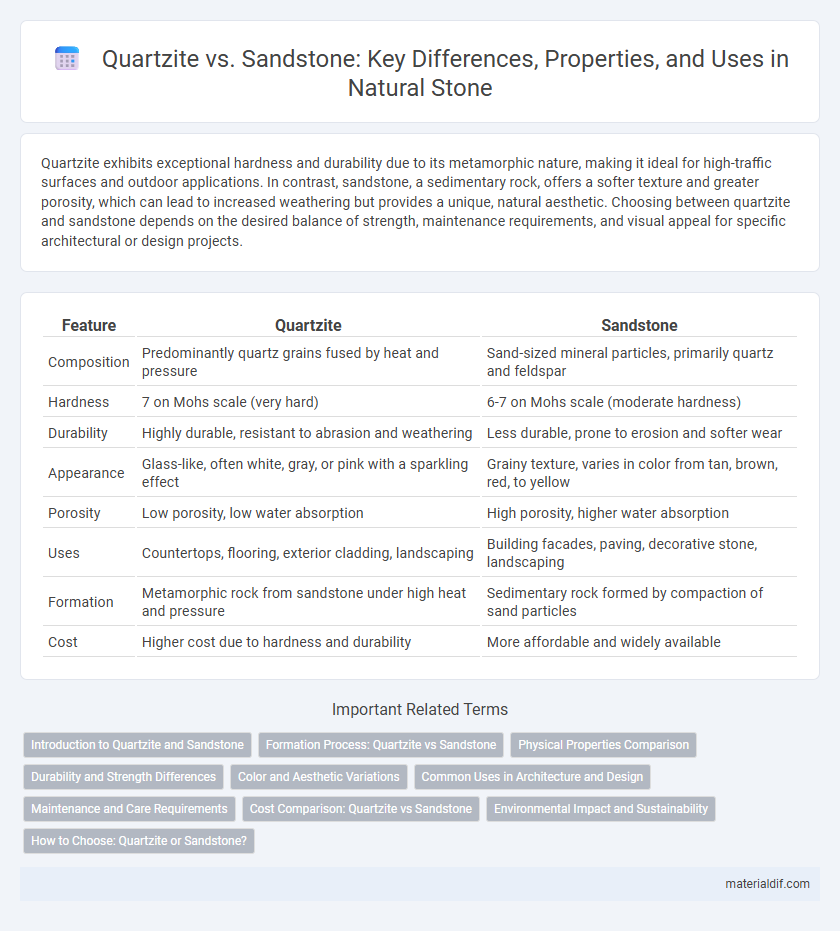Quartzite exhibits exceptional hardness and durability due to its metamorphic nature, making it ideal for high-traffic surfaces and outdoor applications. In contrast, sandstone, a sedimentary rock, offers a softer texture and greater porosity, which can lead to increased weathering but provides a unique, natural aesthetic. Choosing between quartzite and sandstone depends on the desired balance of strength, maintenance requirements, and visual appeal for specific architectural or design projects.
Table of Comparison
| Feature | Quartzite | Sandstone |
|---|---|---|
| Composition | Predominantly quartz grains fused by heat and pressure | Sand-sized mineral particles, primarily quartz and feldspar |
| Hardness | 7 on Mohs scale (very hard) | 6-7 on Mohs scale (moderate hardness) |
| Durability | Highly durable, resistant to abrasion and weathering | Less durable, prone to erosion and softer wear |
| Appearance | Glass-like, often white, gray, or pink with a sparkling effect | Grainy texture, varies in color from tan, brown, red, to yellow |
| Porosity | Low porosity, low water absorption | High porosity, higher water absorption |
| Uses | Countertops, flooring, exterior cladding, landscaping | Building facades, paving, decorative stone, landscaping |
| Formation | Metamorphic rock from sandstone under high heat and pressure | Sedimentary rock formed by compaction of sand particles |
| Cost | Higher cost due to hardness and durability | More affordable and widely available |
Introduction to Quartzite and Sandstone
Quartzite is a durable metamorphic rock formed from sandstone subjected to intense heat and pressure, resulting in a dense, hard surface ideal for construction and decorative purposes. Sandstone is a sedimentary rock composed primarily of compacted sand-sized mineral particles, known for its porous texture and varied color palette. Both stones exhibit distinct properties influencing their applications in architecture, landscaping, and flooring.
Formation Process: Quartzite vs Sandstone
Quartzite forms through the metamorphism of quartz-rich sandstone, undergoing intense heat and pressure that recrystallize quartz grains into a dense, interlocking structure. Sandstone, however, develops from the compaction and cementation of sand-sized mineral particles or rock fragments, predominantly quartz, in sedimentary environments. The metamorphic process of quartzite drastically increases its hardness and durability compared to the sedimentary origin of sandstone.
Physical Properties Comparison
Quartzite exhibits higher hardness and density compared to sandstone, featuring a Mohs hardness of 7 versus sandstone's typical range of 6 to 7. Quartzite's interlocking quartz grains contribute to its superior durability, making it more resistant to scratching and weathering. Sandstone, composed mainly of sand-sized mineral particles like quartz and feldspar, tends to be more porous and less abrasion-resistant than quartzite.
Durability and Strength Differences
Quartzite exhibits superior durability and strength compared to sandstone due to its metamorphic origin, which results in a denser, harder structure with a higher resistance to abrasion and weathering. Sandstone, being a sedimentary rock composed mainly of sand-sized mineral grains, is generally softer and more porous, making it more susceptible to erosion and mechanical wear. The high quartz content in quartzite forms interlocking crystals, enhancing its compressive strength and making it ideal for heavy-duty construction and exterior applications.
Color and Aesthetic Variations
Quartzite exhibits a wide range of vibrant colors, including white, pink, red, and blue, often featuring a glassy or glossy appearance due to its natural quartz content. Sandstone tends to showcase earthy tones such as tan, brown, yellow, and reddish hues, with a more matte and grainy texture that highlights sedimentary layers and fossil imprints. The aesthetic variations between quartzite's durability and brilliance contrast with sandstone's rustic and natural appeal, making them distinct choices for architectural and decorative applications.
Common Uses in Architecture and Design
Quartzite is frequently utilized in high-traffic areas such as kitchen countertops and flooring due to its exceptional hardness and resistance to abrasion, making it ideal for both residential and commercial architectural projects. Sandstone's porous texture and warm tones make it popular for decorative facade cladding, garden pathways, and outdoor landscaping elements, where its natural beauty complements rustic and traditional design themes. Both stones are valued for their aesthetic appeal, but quartzite's durability suits structural applications, whereas sandstone is preferred for ornamental and surface-level uses.
Maintenance and Care Requirements
Quartzite requires minimal maintenance due to its natural hardness and resistance to scratches, stains, and heat, making it ideal for high-traffic areas and kitchen surfaces. Sandstone, while durable, is more porous and softer, which demands regular sealing and gentle cleaning to prevent staining and erosion. Proper care for sandstone involves using pH-neutral cleaners and avoiding acidic substances, whereas quartzite's dense structure allows for easier upkeep with basic cleaning routines.
Cost Comparison: Quartzite vs Sandstone
Quartzite typically costs more than sandstone due to its superior durability and natural resistance to wear and weathering. Sandstone offers a more budget-friendly option, with prices generally 20-30% lower than quartzite, making it suitable for projects with cost constraints. The long-term maintenance and replacement expenses for sandstone often exceed those of quartzite, influencing overall cost-effectiveness.
Environmental Impact and Sustainability
Quartzite offers greater environmental sustainability than sandstone due to its longer lifespan and minimal maintenance requirements, reducing resource consumption over time. The extraction of quartzite typically involves less chemical processing compared to sandstone, which often requires more intensive quarrying and treatment, leading to higher ecological disruption. Choosing quartzite supports environmentally responsible construction by promoting durability and lowering the carbon footprint associated with stone sourcing and fabrication.
How to Choose: Quartzite or Sandstone?
Quartzite offers superior durability, hardness, and resistance to heat and scratching, making it ideal for high-traffic areas and kitchen countertops. Sandstone provides a softer, more porous surface with natural textures that enhance outdoor landscaping and decorative features. Selecting between quartzite and sandstone depends on application requirements, with quartzite preferred for longevity and sandstone chosen for aesthetic warmth and ease of carving.
Quartzite vs Sandstone Infographic

 materialdif.com
materialdif.com